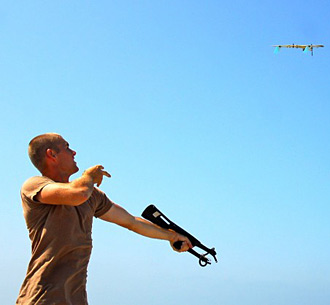
|  |  |  Technology News Technology News  
Air Force Completes Killer Micro-Drone Project
 David Hambling - Wired David Hambling - Wired
go to original
January 08, 2010


| | (U.S. Marine Corps) |  |
The Air Force Research Laboratory set out in 2008 to build the ultimate assassination robot: a tiny, armed drone for U.S. special forces to employ in terminating “high-value targets.” The military won’t say exactly what happened to this Project Anubis, named after a jackal-headed god of the dead in Egyptian mythology. But military budget documents note that Air Force engineers were successful in “develop[ing] a Micro-Air Vehicle (MAV) with innovative seeker/tracking sensor algorithms that can engage maneuvering high-value targets.”

We have seen in recent years increased strikes by larger Predator and Reaper drones using Hellfire missiles against terrorist-leadership targets in Afghanistan and Pakistan. But these have three significant drawbacks.

First, you can never be quite sure of what you hit. In 2002’s notorious “Tall Man incident,” CIA operatives unleashed a Hellfire at an individual near Zhawar Kili in Afghanistan’s Paktia province. His unusual height convinced the drone controllers that the man was Bin Laden (who stands 6 feet, 5 inches). In fact, he was merely an innocent (if overgrown) Afghan peasant.

A second problem is that the Hellfire isn’t exactly the right weapon for the mission. Originally designed as an anti-tank missile, it’s not especially agile, nor is it designed to cope with a target that might swerve or dodge at the last second (like cars and motorbikes).

And thirdly, such strikes tend to affect a number of others, as well as the intended target. It raises the risk of killing or injuring innocent bystanders.

This was the rationale for Project Anubis. Special Forces already make extensive use of the Wasp drone made by AeroVironment. This is the smallest drone in service, weighing less than a pound. It has an endurance of around 45 minutes, and line-of-sight control extends to 3 miles.

It might seem limited compared to larger craft, but the Wasp excels at close-in reconnaissance. Its quiet electric motor means it can get near to targets without their ever being aware of its presence.

The Air Force’s 2008 budget plans described the planned Project Anubis as “a small UAV [unmanned aerial vehicle] that carries sensors, data links, and a munitions payload to engage time-sensitive fleeting targets in complex environments.” It noted that after it was developed by the Air Force Research Laboratory, Anubis would be used by Air Force Special Operations Command. The total cost was to be just over half a million dollars.

No official announcements have been made since then, and the Air Force did not return a request to comment on this story (hardly surprising for a weapon so likely to be used covertly). But the current Air Force R&D budget does mention the effort, briefly. This newer document refers to Project Anubis as a development that has already been carried out. According to the budget, $1.75 million was spent to reach the goal.

The current state of Project Anubis is unknown. It could be one of tens of thousands of military research efforts that started, made some progress and ended without a conclusion. Or Anubis could now be in the hands of Air Force Special Operations Command.

If so, Anubis would solve both of the problems associated with the Predator-Hellfire combination. It would follow and catch the most elusive target, and its ability to take a video sensor close to the target should mean it can be positively identified before the operator has to make a go or no-go decision.

(There may be a classical reference here: The god Anubis was responsible for weighing the hearts of the dead to judge whether they would have eternal life. The Project Anubis MAV will have to make similarly fine judgments.)

A tiny warhead, weighing a fraction of a pound, could mean extremely little collateral damage, compared to the 20-pound warhead on a Hellfire.

I reported in 2007 on a rumor that the miniature Wasp drone (photo at top) might get a lethal “sting.” It now appears that word of this new weaponry was more than idle talk.

See Also:

• Pentagon’s Cyborg Insects All Grown Up
• Hovering Drones Rushed to Iraq (Updated)
• Video: Air Force’s Killer Bugbots Attack
• Video: Pentagon’s Robo-Hummingbird Flies Like the Real Thing
• Strategist: Killer Drones Level Extremists’ Advantage
• Gates, Air Force Battle Over Robot Planes
• Dozen Dead in Latest Pakistan Drone Strike
Why Was Pakistan Drone Strike So Deadly?
• More Killer Drone Bangs For The Buck
|

 |
|  |



